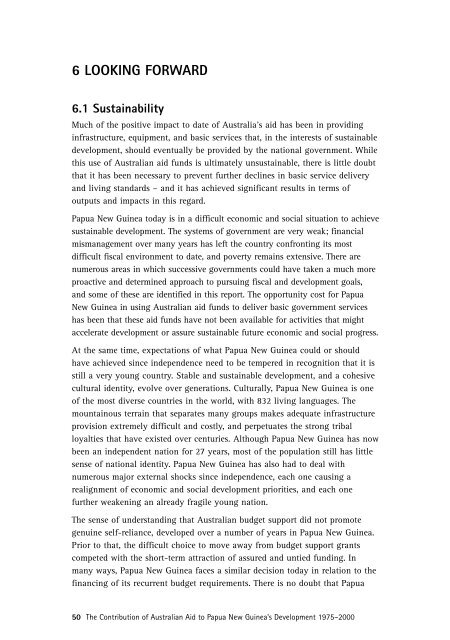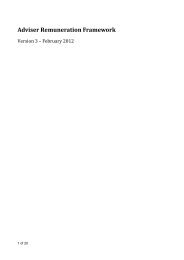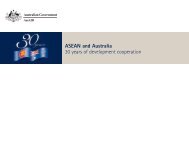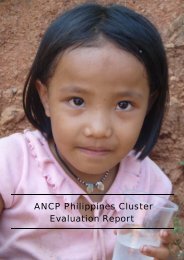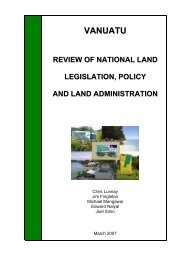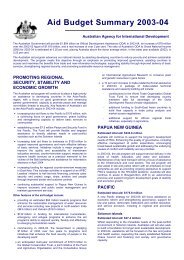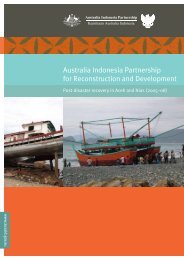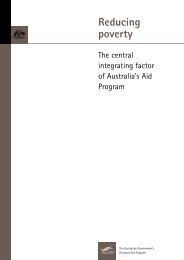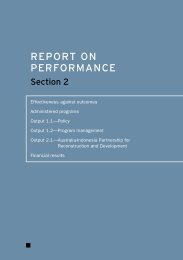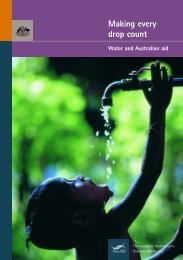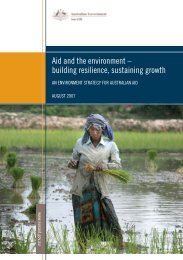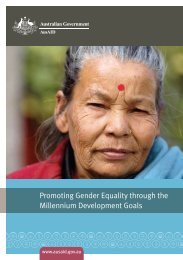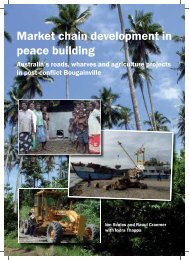Australian Aid to PNG - AusAID
Australian Aid to PNG - AusAID
Australian Aid to PNG - AusAID
Create successful ePaper yourself
Turn your PDF publications into a flip-book with our unique Google optimized e-Paper software.
6 LOOKING FORWARD6.1 SustainabilityMuch of the positive impact <strong>to</strong> date of Australia’s aid has been in providinginfrastructure, equipment, and basic services that, in the interests of sustainabledevelopment, should eventually be provided by the national government. Whilethis use of <strong>Australian</strong> aid funds is ultimately unsustainable, there is little doubtthat it has been necessary <strong>to</strong> prevent further declines in basic service deliveryand living standards – and it has achieved significant results in terms ofoutputs and impacts in this regard.Papua New Guinea <strong>to</strong>day is in a difficult economic and social situation <strong>to</strong> achievesustainable development. The systems of government are very weak; financialmismanagement over many years has left the country confronting its mostdifficult fiscal environment <strong>to</strong> date, and poverty remains extensive. There arenumerous areas in which successive governments could have taken a much moreproactive and determined approach <strong>to</strong> pursuing fiscal and development goals,and some of these are identified in this report. The opportunity cost for PapuaNew Guinea in using <strong>Australian</strong> aid funds <strong>to</strong> deliver basic government serviceshas been that these aid funds have not been available for activities that mightaccelerate development or assure sustainable future economic and social progress.At the same time, expectations of what Papua New Guinea could or shouldhave achieved since independence need <strong>to</strong> be tempered in recognition that it isstill a very young country. Stable and sustainable development, and a cohesivecultural identity, evolve over generations. Culturally, Papua New Guinea is oneof the most diverse countries in the world, with 832 living languages. Themountainous terrain that separates many groups makes adequate infrastructureprovision extremely difficult and costly, and perpetuates the strong triballoyalties that have existed over centuries. Although Papua New Guinea has nowbeen an independent nation for 27 years, most of the population still has littlesense of national identity. Papua New Guinea has also had <strong>to</strong> deal withnumerous major external shocks since independence, each one causing arealignment of economic and social development priorities, and each onefurther weakening an already fragile young nation.The sense of understanding that <strong>Australian</strong> budget support did not promotegenuine self-reliance, developed over a number of years in Papua New Guinea.Prior <strong>to</strong> that, the difficult choice <strong>to</strong> move away from budget support grantscompeted with the short-term attraction of assured and untied funding. Inmany ways, Papua New Guinea faces a similar decision <strong>to</strong>day in relation <strong>to</strong> thefinancing of its recurrent budget requirements. There is no doubt that Papua50 The Contribution of <strong>Australian</strong> <strong>Aid</strong> <strong>to</strong> Papua New Guinea’s Development 1975–2000


